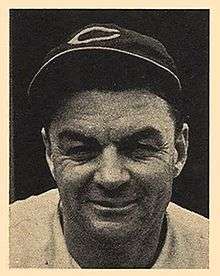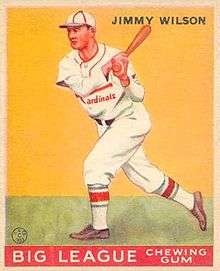Jimmie Wilson (baseball)
| Jimmie Wilson | |||
|---|---|---|---|
 | |||
| Catcher / Manager | |||
|
Born: July 23, 1900 Philadelphia, Pennsylvania | |||
|
Died: May 31, 1947 (aged 46) Bradenton, Florida | |||
| |||
| MLB debut | |||
| April 17, 1923, for the Philadelphia Phillies | |||
| Last MLB appearance | |||
| September 29, 1940, for the Cincinnati Reds | |||
| MLB statistics | |||
| Batting average | .284 | ||
| Home runs | 32 | ||
| Runs batted in | 621 | ||
| Managerial record | 493–735 | ||
| Winning % | .401 | ||
| Teams | |||
|
As player
As manager | |||
| Career highlights and awards | |||
James Wilson (July 23, 1900 – May 31, 1947), nicknamed "Ace," was an American professional athlete in soccer and baseball. He began his professional sports career as a soccer outside right in the National Association Football League and American Soccer League before becoming a catcher, manager and coach in Major League Baseball.
Wilson was the National League's starting catcher in baseball's first All-Star game.
Born in Philadelphia, Pennsylvania, Wilson threw and batted right-handed and was listed at 6 ft 1 1⁄2 in (187 cm) tall and 200 pounds (91 kg).
Soccer
Wilson, the son of Scottish immigrants, grew up in northeast Philadelphia. He left school when he was fourteen to work in a local textile mill. In 1919, he left the mills when he began playing as an outside forward with Philadelphia Merchant Ship B in the National Association Football League. During his time with the team, he met Dick Spalding, another two sport athlete, whom he later hired as his first base coach when Wilson managed the Phillies and Cubs. After Merchant Ship folded following the 1919-1920 season, Wilson moved to Bethlehem Steel F.C., signing with the team in July 1920.[1] During his time in Bethlehem, he also played catcher for the steel company's baseball team which competed in the Steel League. In 1921, Wilson signed with Harrison F.C. in the newly established American Soccer League. He played thirteen league and three National Challenge Cup games, scoring four goals. During the 1922-1923 season, he played four games for Philadelphia Field Club before leaving the sport to concentrate on his baseball career.[2]
Baseball

During his years playing first division soccer, Wilson also made a name for himself as an excellent baseball player. When he signed with Bethlehem Steel in July 1920, the local newspaper stated, "The addition of Wilson would be a most welcome one, because his campaigning on the baseball diamond has been as brilliant as that in soccer circles. At present he is on the receiving end of the battery for the New Haven team in the Eastern League."[1]
In February 1923, he gave up his soccer career when he was traded from New Haven in the Eastern League to the Philadelphia Phillies in the National League for Stan Baumgartner and Jack Withrow. Wilson's National League playing career would stretch over 18 seasons (1923–40) with the Philadelphia Phillies, St. Louis Cardinals and the Cincinnati Reds. He hit over .300 four times as a regular catcher and for his career batted .284 in 1,525 games.
In 1928, he joined baseball history when he was traded by the Phillies to the Cardinals during a game between the two teams. According to one account, "Wilson was a Phil for two innings, then darted into Redbird regalia, and sat on the St. Louis bench, for the remainder of the game."[3] After the 1933 season, he was traded back to the Phillies for fellow catcher Spud Davis and infielder Eddie Delker.
From 1934 through 1938, he was the player-manager of his hometown Phillies, one of the worst teams in baseball at the time. He guided the Phils to three seventh place and two eighth (last) place finishes; in his final season, Philadelphia lost 103 of 149 games. He then joined the Cincinnati coaching staff in 1939 and played only four games that season.
In August 1940, the Reds were stunned when Willard Hershberger, backup catcher to future Baseball Hall of Famer Ernie Lombardi, committed suicide in his Boston hotel room. The 40-year-old Wilson came off the coaching lines and joined the active roster, serving as the club's third catcher behind Lombardi and rookie Bill Baker. He played three games in August, but then in September Lombardi injured his ankle, and Wilson was pressed into starting duty. Splitting time with Baker and Dick West, Wilson played in 16 games during the pennant race, batting .243. When Lombardi was unable to return for more than spot duty in the 1940 World Series, Wilson came through, batting .353 in six games and playing a key role in Cincinnati's defeat of the Detroit Tigers, four games to three, for the world championship.
His stardom in the 1940 Fall Classic led to his second and last major league managing job, with the Chicago Cubs (1941–44), but he never had a winning record in Wrigleyville and his highest finish was fifth, in 1943. The following season, Wison resigned as manager of the Cubs after the team followed up an opening day victory with nine straight defeats to open the season.[4] He was replaced by Roy Johnson for one game before Charlie Grimm took over as manager of the Cubs. His final record as a manager, over nine full or partial seasons was: 493 wins and 735 losses (.401).
Wilson returned to Cincinnati as a coach in 1945–46. Released along with Reds manager Bill McKechnie at the end of the 1946 season, Wilson moved to Florida and entered the citrus growing business. He died suddenly of a heart attack at the age of 46 the following May in Bradenton.
Personal
Wilson was also the father of 2nd Lt. Robert J. Wilson, a B-29 Flight Crew member who died in a training accident in Kharagpur, India November 28, 1944.
See also
References
- 1 2 CHECKING UP ON TRIP SOUTH; The Globe; June 29, 1920 at the Wayback Machine (archived October 21, 2009)
- ↑ Jose, Colin (1998). American Soccer League, 1921-1931 (Hardback). The Scarecrow Press. (ISBN 0-8108-3429-4).
- ↑ A Swing Along Athletic Row; The Globe; May 12, 1928 at the Wayback Machine (archived October 21, 2009)
- ↑ Jimmy Wilson resigns as manager of Chicago Cubs
External links
- Career statistics and player information from Baseball-Reference, or Baseball-Reference (Minors)
- The Deadball Era